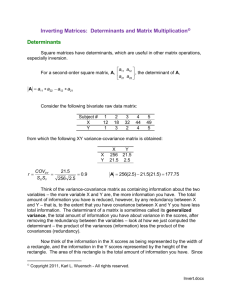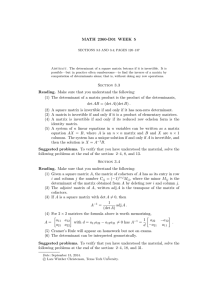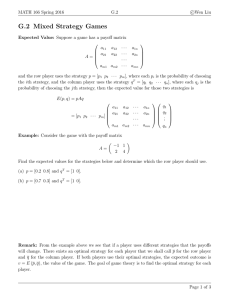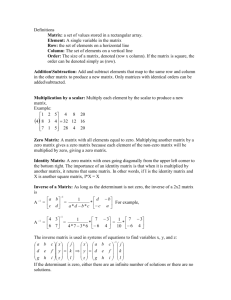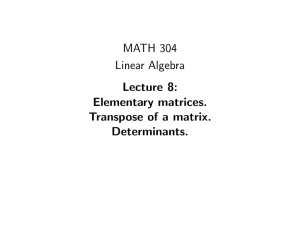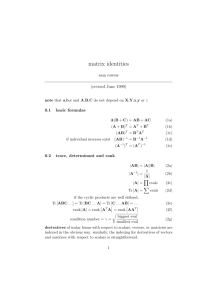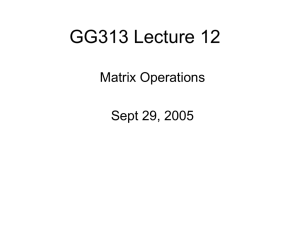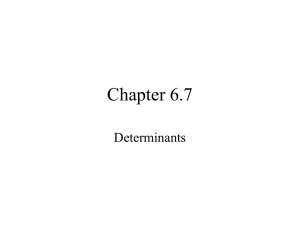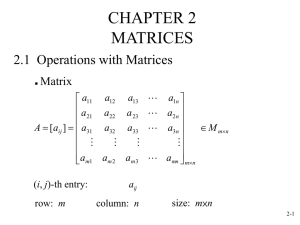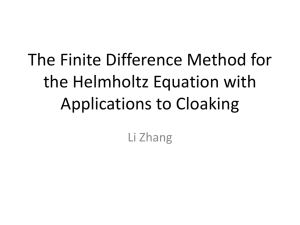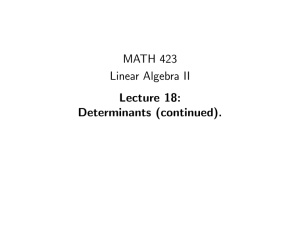Inverting Matrices
advertisement
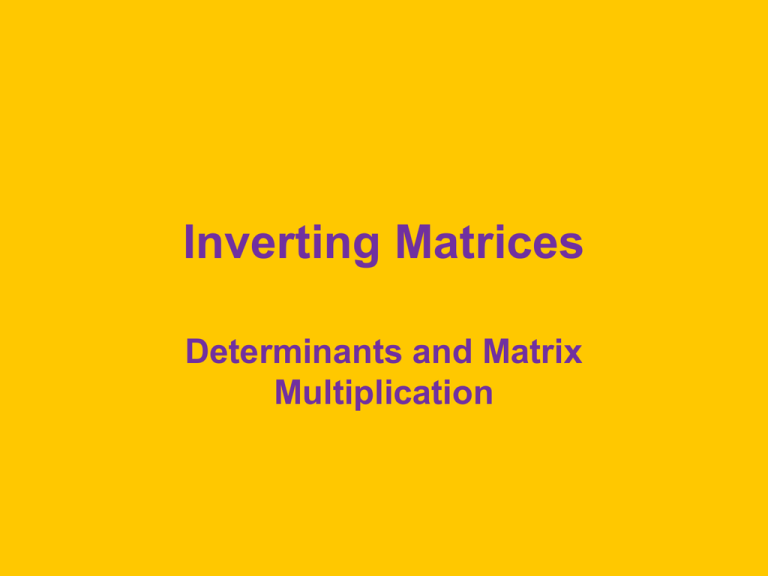
Inverting Matrices
Determinants and Matrix
Multiplication
Determinants
• Square matrices have determinants, which
are useful in other matrix operations,
especially inversion.
a11 a12
• For a second-order square
a a
matrix, A,
21 22
the determinant is
A a11 a22 a12 a21
Consider the following bivariate
raw data matrix
Subject # 1
2
3
4
5
X
12 18 32 44 49
Y
1
3
2
4
5
from which the following XY variance-covariance matrix is
obtained:
X
Y
X
256
21.5
Y
21.5
2.5
COVXY
r
S X SY
21.5
256 2.5
0.9
A 256(2.5) 21.5(21.5) 177.75
Think of the variance-covariance matrix as containing
information about the two variables – the more variable X
and Y are, the more information you have.
Any redundancy between X and Y reduces the total amount
of information you have -- to the extent that you have
covariance between X and Y, you have less total information.
Generalized Variance
• The determinant tells you how much
information the matrix has about the
variance in the variables – the generalized
variance,
• after removing redundancy among
variables.
• We took the product of the variances and
then subtracted the product of the
covariances (redundancy).
Imagine a Rectangle
• Its width represents information on X
• Its height represents information on Y
• X is perpendicular to Y (orthogonal), thus
rXY = 0.
• The area of the rectangle represents the
total information on X and Y.
• With covariance = 0, the determinant = the
product of the two variances minus 0.
Imagine a Parallelogram
• Allowing X and Y to be correlated with one
another moves the angle between height and
width away from 90 degrees.
• As the angle moves further and further away
from 90 degrees, the area of the
parallelogram is also reduced.
• Eventually to zero (when X and Y are
perfectly correlated).
• See the Generalized Variance video clip in
BlackBoard.
Consider This Data Matrix
Subject # 1
X
10
Y
1
2
20
2
3
30
3
4
40
4
5
50
5
Variance-Covariance Matrix
X
Y
COVXY
r
SX SY
X
250
25
25
1
250 2.5
Y
25
2.5
A 250(2.5) 25(25) 0
Since X and Y are perfectly correlated, the generalized
variance is nil.
Identity Matrix
• An identity matrix has 1’s on its main
diagonal, 0’s elsewhere.
1 0 0
0 1 0
0 0 1
Inversion
• The inverted matrix is that which when
multiplied by A yields the identity matrix.
That is, AA1 = A1A = I.
• With scalars, multiplication by
1
a 1.
the inverse yields the scalar
a
identity.
• Multiplication by an inverse
1 a
a .
is like division with scalars.
b
b
Inverting a 2x2 Matrix
• For our original variance/covariance matrix:
A
1
2
2.5 - 21.5
1 a22 - a12
1
*
A 2 - a21 a11 177.75 - 21.5 256
Multiplying a Scalar by a Matrix
• Simply multiply each matrix element by the
scalar (1/177.75 in this case).
• The resulting inverse matrix is:
.014064698
A
- .120956399
1
- .120956399
1.440225035
AA1 = A1A = I
a b w x row 1 col1 row 1 col2
c d y z row col row col
2
1
2
2
256 21.5 .014064698
21.5 2.5 - .120956399
aw by ax bz
cw dy cx dz
- .120956399 1 0
1.440225035 0 1
The Determinant of a Third-Order
Square Matrix
a11 a12 a13
a
a
a
A
21
22
23
3
a31 a32 a33
a11 a22 a33 a12 a23 a31 a13 a32
a21 a31 a22 a13 a11 a32 a23 a12 a21 a33
Matrix Multiplication for a 3 x 3
a b c r s t
d e f u v w
g h i x y z
ar bu cx as bv cy at bw cz
dr eu fx ds ev fy dt ew fz
gr hu ix gs hv iy gt hw iz
row1 col1 row1 col2 row1 col3
row 2 col1 row 2 col2 row 2 col3
row 3 col1 row 3 col2 row 3 col3
SAS Will Do It For You
•
•
•
•
•
•
•
•
•
Proc IML;
reset print; display each matrix when created
XY ={
enter the matrix XY
256 21.5, comma at end of row
21.5 2.5}; matrix within { }
determinant = det(XY); find determinant
inverse = inv(XY);
find inverse
identity = XY*inverse;
multiply by inverse
quit;
XY
2 rows
256
21.5
DETERMINANT
INVERSE
IDENTITY
2 cols
21.5
2.5
1 row
177.75
2 rows
0.0140647
-0.1209560
2 rows
1
-2.08E-17
1 col
2 cols
-0.120956
1.440225
2 cols
-2.22E-16
1
